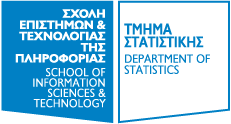Time Series Analysis (8 ECTS)
Introduction with examples of time correlated data. Concepts of stationarity. Autocorrelation function of stationary time series. The classic additive model with deterministic components (trend, periodicity/ seasonality). Parametric and non parametric methods of estimating and eliminating deterministic components, the method of differences. Box Cox transformations for eliminating heteroscedasticity. Classic tests for randomness and normality of the stochastic component. Linear filters of stationary series autocorrelation. Stationary series representation as linear filters of uncorrelated noise and Wold's theorem. Autoregressive moving average model (ARMA), conditions for the existence of causality - reversibility of stationary linear solutions. Calculating the auto-covariance function of causal stationary solutions in the general ARMA(p,q) model. Asymptotic qualities of the mean. Bartlett's theorem and asymptotic statistical inference for autocorrelations. Predicting the minimum mean squared error. Algorithms for calculating optimal linear predictions functions (Durbin-Levinson, innovations) and its applications in predicting causal stationary ARMA models solutions. Partial autocorrelation function and its estimation.
Fitting causal stationary ARMA models:
a) preliminary estimators for autoregressive AR(p) models (Yule-Walker, least squares), moving average MA(q) models (innovations, algorithm), mixed ARMA(p,q) models, (generalised Yule-Walker method), innovations algorithm),
b) maximum likelihood estimation and asymptotic inference. Diagnostic tests and criteria for choosing ARMA models rank (FPE, AIC, BIC).
Introduction to ARIMA and SARIMA models for non stationary time series with a unit root, Dickey - Fuller test.
Recommended Reading
- Μπόρα-Σέντα Ε., Μωυσυάδης Χ.Θ., Εφαρμοσμένη Στατιστική, Εκδόσεις Ζήτη, 1990.
- Zivot, Eric.Wang, Jiahui, Modeling Financial Time Series with S-PLUS, Springer Science and Business Media Inc., 2006.
- Shumway, Robert H., Stoffer, David S., Time Series Analysis and its Applications, Springer Science and Business Media LLC, 2006.
- Gilgen, Hans, Univariate Time Series in Geosciences, Springer-Verlag Berlin Heidelberg, 2006.
- Kirchgassner, Gebhard, Wolters, Jurgen, Introduction to Modern time Series Analysis, Springer-Verlag Berlin Heidelberg, 2007.
- Δαμιανού Χαράλαμπος Χ., ΜΕΘΟΔΟΛΟΓΙΑ ΔΕΙΓΜΑΤΟΛΗΨΙΑΣ, Εκδόσεις “σοφία”, 2007.
- Brockwell, P.J. and R.A. Davis (2002, 2nd Edition): Introduction to Time Series and Forecasting, Springer Verlag.
- Brockwell, P.J. and R.A. Davis (1991, 2nd Edition): Time Series: Theory and Methods, Springer Verlag.
- Cryer, J.D. and K.S. Chan (2008): Time Series Analysis With Applications in R, Springer-Verlag.
- Δημέλη Σ. (2003, 3η Έκδοση): Σύγχρονες Μέθοδοι Ανάλυσης Χρονολογικών Σειρών, Εκδόσεις ΚΡΙΤΙΚΗ, Αθήνα.
The courses outline can be found here.





 Patision 76
Patision 76 2108203 112 /
2108203 112 /
